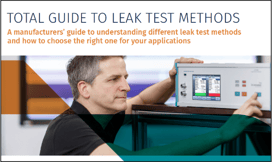In manufacturing, maintaining the accuracy of your leak test machine and system is essential to ensuring product quality and compliance. One of the most effective yet often overlooked tools in this process is the use of a “test leak”, or master leak— a calibrated reference standard that simulates a known leakage rate.
By regularly verifying your leak tester against a test leak, you can confirm measurement stability, detect drift, and avoid costly false passes or failures. In this post, we'll explain what a test leak is, why it's critical to your leak testing process, and how to use it properly to keep your equipment performing at its best.
EXPLORE INNOMATEC'S TEST LEAKS →
What it is a test leak?
Test leaks, or master leaks, are reference standards built to a specific leakage rate, used to calibrate and ensure the accuracy of your leak test machine. They can be used for nearly any leak test method, including pressure difference, flow, and trace gas.
How do you use a test leak?
To begin a machine check using a test leak, the operator will test their leak test machine to make sure it is working correctly. To do this, they will connect a leak-tight master part to the machine and run the leak test process. The results should be nearly zero leaks, confirming that this part is still considered a leak-tight part.
The second step of this process is to add the test leak at a test leak coupling (or anywhere applicable in/on the machine*) and run a second test. The second test results should be the same as the known leak being simulated by the test leak.
After this process, you can be sure that your leak test machine is well-calibrated and ready to reliably detect leaks as intended.
*Note: Test leaks can be applied to a test in a variety of ways, including manually on the front of a leak tester, integrated into the leak tester, or directly on the master part for a quicker, more streamlined process.
What happens if you don’t use a test leak?
If a manufacturer decides against using a test leak, it is not possible to truly determine the volume of the component. This is essential for pressure differential measurement in order to perform an evaluation based on the leak rate. Furthermore, only a test leak makes it possible to compare different production systems with each other, even if they are not identical in terms of design and system concept.
How often should you use a test leak?
It is recommended to conduct a test leak calibration on leak test machines at the beginning of every shift change. It should also be used after any tool changes or with specific incidents, discrepancies, or repairs that may have affected the machine. Calibrating your machine on a shift-basis ensures that your machine is always measuring and detecting leaks accurately.
While some manufacturers may choose to calibrate only once per week, etc., this means that your machine may be letting through NOK parts—and you would have a whole week’s worth of produced parts to check again to ensure product quality. Testing at the beginning of every shift change ensures a tight control on product quality.
Contact innomatec for reliable, high-quality test leaks
innomatec offers reliable, high-quality test leaks for nearly any application. Designed with a glass capillary tube (as opposed to metal), innomatec’s test leaks are reliable and consistent against the biggest factor that could affect results, the temperature. innomatec’s team will help you select the right test leaks for your needs.
Are you testing many different leak rates? Check out the DF-10 Leak Simulator!
innomatec’s DF-10 Leak Simulator is a leak simulator and instrument calibrator tool. The DF-10 can be set to the different specifications you require across your line, as opposed to a “static” leak rate offered by a standard test leak. If you are required to control many machines with different leak rates at the same site, the DF-10 could be a more economical option for leak test calibration. Learn more →
*Note: Annual recalibration of your test leak(s) is recommended. At innomatec, a calibration work certificate (or optionally a DAkkS calibration certificate is available, depending on leak rate, etc.) is supplied with each test leak.
Want to learn more about innomatec's test leak, DF10, and calibration services?
Contact us today!








